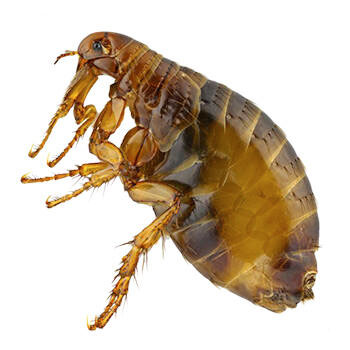Pest Control for Fleas
What Are Fleas?
Fleas are tiny insects that survive by attaching themselves to bird and mammal hosts, most often in wooded areas. There are over 2,500 different species of fleas found around the world. Fleas are known as one of the world’s best jumpers, able to leap more than 150 times their body length. As parasites, fleas survive on the blood of their host.
The flea control experts at Peachtree Pest explain these wingless insects go through four stages of growth: egg, larva, pupa, and adult. Their average life cycle lasts about three weeks, but fleas are hearty pests. Fleas can speed up or slow down the transition to another stage to adapt to changing conditions. Adult female fleas lay an average of 20 eggs per day but can have more than 50 in an ideal environment. To protect your Atlanta, Augusta, Fayetteville, Woodstock, Suwanee, Marietta, Hiram, and Aiken SC home or business from fleas, you need to learn about the behavior of this pest, take steps for prevention, and find effective treatment options should an infestation occur.

How Can I Identify a Flea?
Adult fleas average 3 mm (0.12 in) in length and are dark brown. Fleas have six legs, and their bodies are oval-shaped and brown in color. Fleas are invisible to the naked eye during their other life stages. Fleas have legs that are strong claws, enabling them to grip their host for days.
Fleas are often identified when you see a tiny speck jumping here or there. If you’re looking closely at a pet or something similar, you might see a dark spot moving through fur or carpeting, explain the flea control experts at Peachtree Pest. In many cases, you won’t realize there are fleas around until you or your pets are itching from flea bites.
How Do I Get a Flea Problem?
Anyone can get a flea infestation, especially in wooded areas like those found in Atlanta, Augusta, Fayetteville, Woodstock, Suwanee, Marietta, Hiram, and Aiken SC. Pet owners are at the most risk, but fleas live in urban and rural areas around the world. All Fleas need to survive is a host, though they prefer warm and moist climates, explain flea professionals at Peachtree Pest Control.
Pet owners must often take flea prevention steps to keep their furry friends free of these pests. Fleas can easily jump onto your cat or dog when wandering outside, or even directly onto you. If you’ve got a flea problem in your Atlanta, Augusta, Fayetteville, Woodstock, Suwanee, Marietta, Hiram, and Aiken SC home or business, you’ve probably got a flea infestation in your yard or nearby green area. Any pet or person who has been around fleas can become a carrier for fleas and their eggs to new locations.

What Are the Effects of Fleas in a Home or Business?
Having fleas in your home or business can cause problems for both you and your pet. Flea bites are itchy and irritating, and many pets develop an allergic reaction to them. What’s worse, fleas can carry several types of viruses and bacteria that can be transmitted through a bite to humans or animals. Fleas can pass on the Bartonella henselae bacteria to cats, for example, which can become cat scratch fever if subsequently transmitted to a person. Parasites like tapeworms can easily be passed on to pets by ingesting fleas or their eggs. While fleas do not cause direct structural damage to your Atlanta, Augusta, Fayetteville, Woodstock, Suwanee, Marietta, Hiram, and Aiken SC home or business, they can cause direct damage to the health of you, your family, pets, customers, or employees.
How Do I Prevent Getting Fleas?
There are a few ways you can prevent a flea infestation in your home or business.
If you have pets, preventing fleas starts there. The flea control experts at Peachtree Pest Control recommend giving them a regular flea treatment that will get rid of the adult fleas, larvae, and eggs. Because a flea’s life cycle can span more than a month, you will most likely need to treat your pet multiple times to solve the problem. If regular medication doesn’t seem to work or your pet responds badly to the bites or treatment, consider visiting a veterinarian.
Unfortunately, you will also need to treat any carpets, upholstery, bedding, and baseboards where the fleas or their larvae could be. If your flea infestation is minor, you may be able to simply vacuum and wash the linens to eliminate any remaining pests. More serious cases will require treatment from a pest control professional, like Peachtree Pest Control.
If you have a yard or nearby green patch with fleas, you’ll bring them into your house or business every time you walk across the grass. Mowing your lawn and trimming your shrubbery and trees can keep flea populations from exploding. Flea professionals at Peachtree Pest also recommend maintaining outdoor areas that are clean and free of food (pet bowls, etc.) discourages animals like opossums, raccoons, and mice from visiting with their fleas as well.
Flea control experts at Peachtree Pest Control explain fleas are so tiny and can multiply so rapidly, flea infestations can become overwhelming in a matter of weeks. Especially in the heavily forested states of Atlanta, Augusta, Fayetteville, Woodstock, Suwanee, Marietta, Hiram, and Aiken SC, a pest control professional may be your only hope of solving a persistent flea problem. Pest control experts can help you get rid of fleas with the first round of treatments, saving you tons of time in the process.

Protecting Your Home or Business From Fleas With Peachtree Pest Control
Peachtree Pest Control offers expert treatment designed to effectively and efficiently control and prevent pests from invading your home or business in Atlanta, Augusta, Fayetteville, Woodstock, Suwanee, Marietta, Hiram, and Aiken SC. Our use of Integrated Pest Management (IPM) techniques focuses on finding the core of the pest concern and controlling Fleas from the source. Through IPM, pest control materials are selected and applied in a manner that minimizes risks to human health, pets, and the environment.
Call Peachtree Pest Control today for your FREE and NO OBLIGATION estimate at 855-732-2487 or Schedule Online today!






